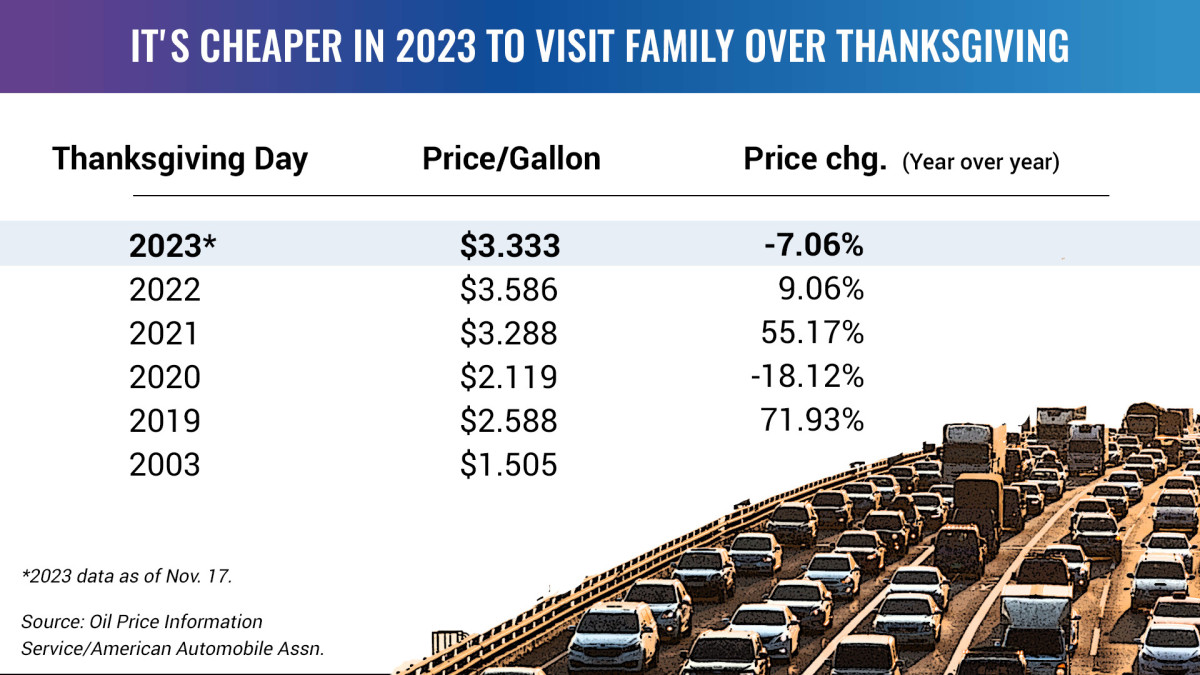
Driving to see your parents, siblings, or friends over the Thanksgiving holiday can be stressful.
The highways are typically filled with people wanting to get from A to B and back again as quickly as possible with as little stress as possible.
One stress point for Thanksgiving driving this year will be a bit lower this week. Gasoline prices are down more than 14% since September and 7% from Thanksgiving 2022.
So, be thankful: The hit on your bank account this year may not be so severe.
The national average price of gasoline is just about $3.313 per gallon, according to the American Automobile Association. The national average has come down for 60 out of the last 62 days. And the two days where prices didn't fall? There was no price change.

TheStreet
If you're planning to drive 200 miles one-way for the holiday with maybe 50 miles of incidental driving at your destination, your gasoline bill for the 400-mile trip may be just under $60. A year ago, the cost would have been about $65. (Not including meals and snack breaks.)
Eleven states, in the South and Midwest, are showing statewide averages under $3 a gallon. The lowest statewide average is Mississippi at $2.796 a gallon as of Nov. 19. The lowest price was rural Jones County at $2.601.
The average price in California, the priciest state, is now $4.989 a gallon, down 14% from its September peak. In car-happy Los Angeles, the average is about $5.09. In Tehama County, in the northern California, the price is $4.55.
The decline this Thanksgiving is the first after two sizeable increases in 2022 and 2021
- A 9% gain in 2022 to $3.586. That was the year the AAA price peaked at $5.016 a gallon and then fell sharply.
- A 55% gain in 2021 to $3.288 in the initial recovery from the pandemic.
Economic and political forces buffet prices
To be sure, a price around $3.30 is still quite high, more than double the price at Thanksgiving 2003, which was $1.51 a gallon, according to AAA and its data provider, the Oil Price Information Service.
But a lot has happened since 2003: two major recessions that caused oil and gasoline prices first to fall sharply (18.1% in 2020 alone) and then to rise sharply as recoveries emerged.
In addition, prices have been forced higher in the last few years primarily by the Organization of Petroleum Exporting Countries' moves to restrict global oil supplies and boost prices especially after the Covid-19 pandemic.
A contributing factor to the gas-price declines this year has been growing sales of electric vehicles. According to Cox Automotive and Kelley Blue Book, EVs now represent about 15.6% of total vehicle sales in the United States.
The share will likely grow, but the percentage gains may not to be so big. Many consumers are resisting the higher prices on many vehicles. Luxury-car dealers have been complaining about growing inventories on their lots.
One last point: Gasoline prices have seasonal patterns. They fall in the fall as driving demand falls back and start to rise in the spring as refiners prepare for more driving in summer. So, yes, there will be higher prices, probably in the spring and early summer.







